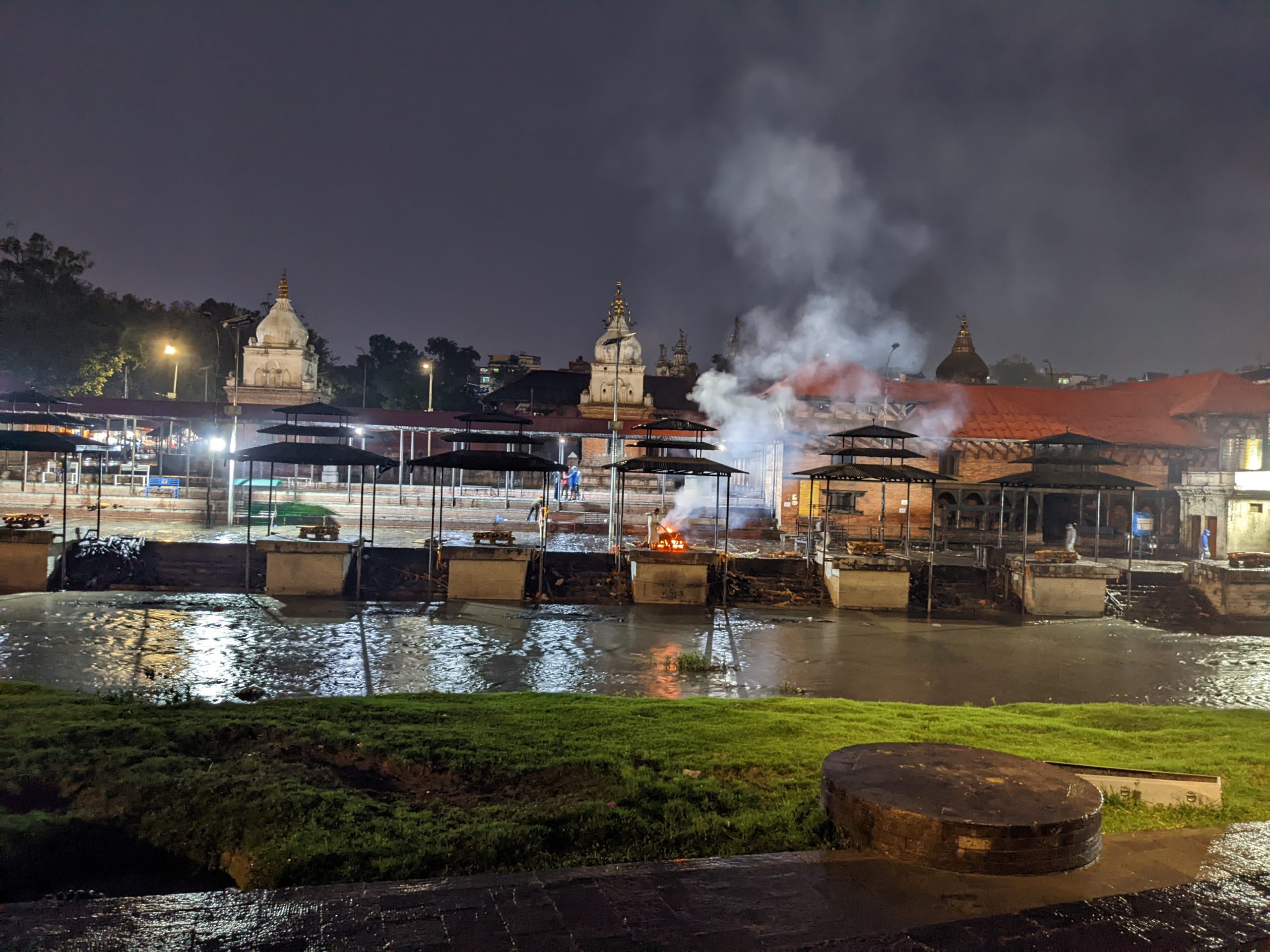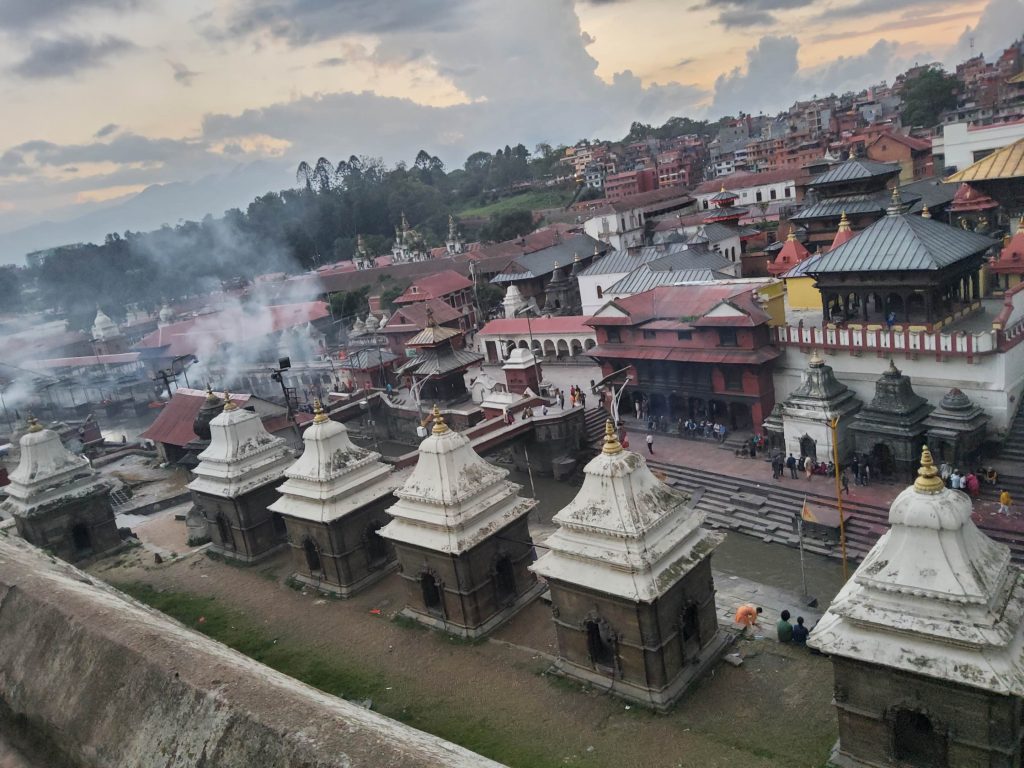
Ghats: A personal account of rituals and feelings surrounding a Hindu tradition – part one.
INTERVIEW | TRAILOKIYA RAJ BAJGAIN
Ghats, in sources as wide-ranging as UNESCO websites, to published architecture research articles, are variously described as “steps and landings,” “stepped bathing places,” or “riverside architecture.” However they are described, these stone structures hold a place of great societal significance in India and Nepal. In this interview, Raj reflects on his memories, understanding, and the cultural significance of ghats to the culture of his home country, Nepal.
Ghats: 围绕印度教传统的仪式和感受的个人叙述–第一部分
从联合国教科文组织的网站到公开发表的建筑研究文章,人们对Ghats的描述多种多样,如 “台阶和平台”、”阶梯浴场 “或 “河边建筑”。无论如何描述,这些石头建筑在印度和尼泊尔都具有重要的社会意义。在这篇访谈中,Raj,一个土生土长的尼泊尔人,向我们介绍了 Ghats 的文化意义。


Austin
Austin: Raj wrote this beautiful essay for Meridian about the Ghats, these cremation pyres in India and Nepal. That piece is available also on our website and I would encourage anyone who is interested to check it out! In this interview, he will share with us in a little more detail what these are and what role they play in his culture.
Raj, thank you for taking the time to be interviewed!
Nino will start us off with some questions and anyone else, feel free to jump in and make other remarks.

Nino
Nino: To start us off, for those of us who are not familiar with the concept, could you briefly explain what the Ghats are?
Raj: Basically ‘Ghats’, most of the time, refers to stone structures alongside the riverbank that can be used for a lot of things, not necessarily cremation pyres, although those are also Ghats. So, for example, a Dhobi Ghat is still a ghat but refers to the place where one would wash their clothes.
One of the most famous Ghats, and often what people think of when they hear the word, is the Shamshan Ghat or the cremation Ghats, those structures besides cremation grounds. That is where people carry out the rituals needed to send their loved ones to heaven.
In the Hindu belief system, once you die, your soul, or your physical remains need to be carried to the heavens, and that duty is performed by Mother Ganges (the holiest of rivers), but in Nepal we don’t have the Ganges. However, we believe that every river flows down to the Ganges— at least every river from Nepal. So, it would be the carrier, or the ‘mother’, that would bring your soul to liberation.
To make it simpler, Ghats are the platforms where we cremate people and they are located alongside the riverbank, making it easier to put people’s remains on the river directly, allowing them to reach heaven and be liberated as soon as possible.
Raj:基本上,”Ghats “在大多数情况下是指河岸旁的石头建筑,它们可以用来做很多事情,不一定非得是火葬场。例如,Dhobi Ghat 仍然是 Ghat,但指的是人们洗衣服的地方。
最有名的高塔之一,也是人们听到这个词时经常想到的,就是沙姆山高塔(Shamshan Ghat)或火葬高塔(the cremation Ghats),那些除了火葬场之外的建筑。人们在这里举行送亲人上天堂所需的仪式。
在印度教的信仰体系中,人死后,灵魂或遗体需要被送往天堂,而这一职责由恒河(最神圣的河流)来履行,但恒河不流经尼泊尔。不过,我们相信每条河流都会流向恒河–至少是尼泊尔的每条河流。因此,恒河是载体,或者说是 “母亲河”,它将把你的灵魂带向解脱。
更简单地说,Ghats 是我们火化人的平台,它们位于河岸旁,这样可以更方便地将人的遗体直接放在河上,让他们尽快到达天堂获得解脱。

Raj


Nino
Nino: Interesting, and to you personally, what goes through your mind when you think of going to the ghats? What is pulling you to that place?
有趣的是,就你个人而言,当你想到去Ghats时,脑海中会闪过什么?是什么吸引你去那个地方?
Raj: So, the ghats are supposed to be kind of scary. The place grandmas tell you to stay away from. There are the sages that live in cremation grounds and put all the ashes from the dead in their body and even sometimes eat the remaining flesh from the pyre and then drink water on the deceased’s skull – they are called Kapalis.
There is a belief that as soon as the smoke of the bones hits you, you must take a ritual bath, because your body would be impure. But the fascinating fact about ghats is that it has always been a draw for the curious.
I had an experience that I consider spiritual and transformative which occurred in 2016 or 2017. One day, I was walking and felt a strange sensation. I decided to sit around a ghat and since it is an open space — I sat on a bench and observed a pyre being made. I witnessed the whole ritual. I could only see one leg of the deceased, which had come out of the pyre, and I watched as it changed colors turning yellow and then black. I could smell the fat burning. I sat there for about three hours, observing the human body reduced to ashes. People assumed I was part of the mourning family, so no one bothered me.
Ghats被认为是有点可怕的,是那种奶奶告诉你要远离的地方。有一些圣人住在火葬场里,他们把死者的骨灰装进自己的身体里,有时甚至吃掉火葬场里剩下的人肉,然后用死者头骨盛水喝–他们被称为卡帕利人。
有一种信仰认为,一旦燃烧尸骨的烟雾碰到你,你就必须洗个仪式澡,因为你的身体会收到玷污。正是这些关于ghats的令人吃惊的事实或传闻,让它如此让人好奇。
在2016 还是 2017 年,我有一次深刻的Ghats体验,它在灵性和精神上影响了我。有一天,我走在路上,感到一种奇怪的直觉。我决定围着 Ghat 坐下,因为它是一个开放空间–我坐在一张长凳上,观察着一个进行中的火葬。我目睹了整个仪式。我只能看到死者的一条腿,它从火堆中伸出来,我看着它变色,先变成黄色,然后是黑色。我能闻到脂肪燃烧的气味。我在那里坐了大约三个小时,看着人体化为灰烬。人们以为我是丧家的一员,所以没有人打扰我。

Raj
Raj: There was a strange attraction to this impure, scary, yet open and accessible event. The main thing was its accessibility. My grandmother would warn of ghosts or lingering spirits around the ghats which could follow you home and haunt you, but I found the experience intriguing. Suddenly it popped into my head that it was the same smell that consumes the streets when shops are making their rotisserie chickens. Witnessing death and the powerful smell, like burning chicken flesh, was an odd realization. Smoke and ashes filled the air, offering an overwhelming sensory experience. It is an experience that hits you and calms you down at the same time. That was my first encounter and the start of my relationships with Ghats.
这种不纯的、可怕的,但又公开的、可接近的活动有一种奇特的吸引力,最主要的是它很容易遇到。我的祖母会警告我Ghats周围会有鬼魂或阴魂不散的幽灵,它们会跟着你回家并缠着你,但我觉得这种体验很有趣。突然间,我想到街上的店铺在烤鸡时也会散发出同样的味道。亲眼目睹死亡和那股强烈的气味,就像烤鸡肉一样,给我一种奇怪的顿悟。烟雾和灰烬弥漫在空气中,给人一种难以抗拒的感官体验。这种体验让你感到震撼,同时又让你平静下来。这是我与Ghats的第一次邂逅,也是我与它关系的开始。

Raj

Austin
Austin: That is fascinating! And it is interesting how these happen in a public space too. Are there multiple Ghats around? As you walk around Kathmandu, would there be differences between the Ghats or preferences of places which people would give to performing these rituals in?
这太有趣了!有趣的是,这些都发生在公共场所。那时候你周围有多个 Ghats 同时进行吗?在加德满, Ghats之间会有什么不同吗?人们对Ghats举行的地点有偏好吗?
Raj: There are a couple of famous Ghats in Kathmandu. Aarya Ghat, most famous in Nepal, is where our kings were burned for centuries. The most famous Ghat for all the Hindus are the Varanasi Ghats in a very famous city called Kashi, in India. According to stories, if you die in that city, the Lord Shiva himself would carry your soul to liberation. It literally became a city where people travel to just to die.
加德满都有几个著名的 Ghats地点。Aarya Ghat 是尼泊尔最有名的 Ghat地点,几个世纪以来,我们的国王都在这里被火葬。对所有印度教徒来说,最有名的 Ghat 是位于印度著名城市喀什的瓦拉纳西 Ghat。据说,如果你死在那个城市,湿婆神就会亲自带着你的灵魂去解脱。因此,这座城市成了人们为死而去的地方。

Raj


Nino
Nino: That is very interesting that people travel to a different city just to die there. How do they plan the whole process? Is there a timeline of when you should travel to Kashi? How does it work?
人们去另一个的城市只是为了死在那里,这很有趣。他们是如何计划整个过程的?有没有一个时间线关于人什么时候应该去喀什?这个过程是如何进行的?
Raj: In the old days, only the rich and affluent could travel. Back in the day, members of the Court would build private houses called Ashrams, and rich and affluent people would buy properties in Kashi, just to stay until they died.
Today, fewer people still practice this but there are what we call “old days” homes, what Americans might call retirement homes maybe, these homes were built just so that you can wait for your death.
While people wait, they would practice religious rites, performing ritual prayers all day. Most of the time, those people would be widows since if there is still a male member in the house, there is still a head to hold the family together. Once they pass, the wives sometimes feel they would rather just relocate to be alone and in peace. In some cases, older people are thrown out of their homes by other family members and sent to these “old day” homes to await their death.
如今,这样做的人越来越少了,但还是有我们所说的 “旧日 “住宅,也许就是美国人所说的养老院,这些住宅就是为了让你等待死亡而建的。
在等待的过程中,人们会举行宗教仪式,整日进行祭祀祈祷。大多数情况下,这些人都是寡妇,因为没有一个男人来支撑家庭。一旦丈夫去世,妻子们有时会觉得自己宁愿搬到别处安享晚年。在某些情况下,老年人会被其他家庭成员赶出家门,送到这些 “养老院 “等待死亡。

Raj

Nino
Nino: Kashi is in India, no? So, what about in Nepal? What is the oldest Ghat in Nepal?
喀什在印度,不是吗?那么尼泊尔呢,尼泊尔最古老的 Ghat 是什么?
Raj: As long as there was a river and the city of Kathmandu, there was a Ghat. It dates back to forever for us, practically. At least 2000 years I would say, because the settlement in Kathmandu has a proper history of more than 2000 years.
只要有河流和加德满都这座城市,就有 Ghat。我认为至少有 2000 年的历史,因为加德满都的居住区已经有 2000 多年的历史了。

Raj


Austin
Austin: Does every city in Nepal have a Ghat, or cremation pyres?
尼泊尔每个城市都有Ghat或火葬台吗?
Raj: No, only where there are rivers. There are two kinds of cremation Ghats. One is a permanent Ghat, where there is a holy river flowing and a permanent stone structure, where you can have a proper cremation. In my village we don’t have that. Although we have a holy river, we don’t have a fixed cremation pyre. In a permanent Ghat, there would be bodies burning 24/7— it’s well organized. For non-permanent Ghats, family members of the deceased would have to carry all the firewood, go to the riverbank, build the pyre there by themselves, burn the body by themselves, and do all the rituals by themselves.
In Kathmandu, on the other hand, not only are there permanent ghats but there are people who would streamline the process for money.
不,只有有河流的地方才有。火葬高塔有两种。一种是永久性的 Ghat,那里圣河流过,还有一个固定的石头建筑用来火化。在我住的村子里没有这样的地方。虽然我们有一条圣河,但我们没有固定的火葬台。在永久性的 Ghat,会进行全天候的火葬–它们组织得很好。而在非永久性的 Ghat 上,死者家属必须搬运所有的木柴,自己在河岸搭建火堆和焚烧尸体,所有的仪式都需要自己完成。
虽然加德满都有永久性的 Ghats,但还是有人为了钱简化整个过程。

Raj

Austin
Austin: So, the ritual is the same, but in the big cities or special places they might have a permanent installation where they do it, got it.
所以,仪式是一样的,但在大城市或特殊的地方可能会有一个永久性的装置。

Nino
Nino: In the building process, do the close family members have to do it? Or are there people that are hired for that?
在建造过程中,是必须由近亲属来做吗?还是雇人来做?
Raj: In the old days everything had to be done by the family. The pyre had to be built by family members— everything. Now, in the big cities especially, you can pay something like 4500 rupees (around $50-60) for others to do it for you. So, usually, or better, traditionally, it must be done by the family, but in Kathmandu that is no longer common practice — you just streamline the process.
在过去,仪式全部都得由死者的家人完成。火堆是家庭成员搭建的,等等所有的一切。现在,尤其是在大城市,你可以花 4500 卢比(约合 50-60 美元)请人代劳。虽然通常情况下,或者说传统上,必须由家人来完成,但在加德满都,这种做法已不再普遍–仪式已经被流程化了。
Raj: Now, they even have an electric one, where the process is easier since you use electric chambers. And it’s even cheaper because the government subsidizes those companies to prevent the burning of wood.
Here, the two closest Ghats to the temple are called Aarya Ghats (the ghat of the nobles) but there are 5 or 6 other ones a little farther away from the temples. According to the local agents, the two closest ones to the temple are the main Ghats, the holiest of the Ghats. Coincidentally, one of them is where all our kings have been cremated.
现在,我们有了过程更简单和环保的电火化。而且价格更便宜,因为政府会对这些公司进行补贴,避免燃烧木材造成环境污染。
在这里,离寺庙最近的两个嘎塔被称为阿里亚嘎塔(贵族嘎塔),但离寺庙稍远的地方还有五六个嘎塔。据当地人说,离寺庙最近的两个Ghats是主Ghats,也是最神圣的。很巧的是,我们所有的国王都是在其中之一的Ghats火化的。
Raj: It is also important to note that in the old days, only people from a certain economic class and from a certain caste would be allowed to be burned in that specific Ghat, known as the Ghat of the noble ones. Then we had the revolution and the switch to democracy, but still today those Ghats are more expensive, they will charge you twice the normal rates. It is a lot of money, sometimes even a year’s worth of the family’s income. In a sense, you are separated even at the time of your death.
还需要注意的是,在过去,只有来自特定经济阶层和种姓的人才能在贵族 Ghat被火葬。虽然革命之后转向了民主,但如今这些 Ghat 仍然更贵,使用费用在两倍于正常价格。这真的是一大笔钱,有时甚至是一个家庭一年的收入。从某种意义上说,即使在你死的时候,还是会受到阶级的影响。

Raj

Nino
Nino: That’s fascinating. So even death is not an equalizer.
太有意思了,看来即使死亡也不是平等的。

Raj
Raj: Yeah, even after you are no longer here, your body still must fight the last battle.
是的,即使你不在了,你的身体还得打最后一仗。
– To be continued –
